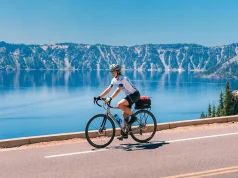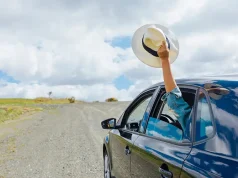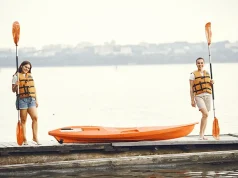
Skiing under the stars adds a whole new dimension to the thrill of winter sports. Whether you’re a seasoned skier looking for a unique experience or a novice adventurer seeking a different challenge, night skiing can be an exhilarating endeavour.
Ski expert SIA Austria shares top tips for preparing for a night skiing adventure, ensuring that you not only stay safe on the slopes but also capture unforgettable moments and fully embrace the magic of skiing after sunset.
Why you should try night skiing?
Skiing along the floodlit slopes, enjoying the starry sky night, and extending your après-ski life is definitely a great way to elevate your skiing holiday. And while daytime slopes may be flooded with snow-eager adventurers, especially during high season, night skiing attracts up to 50-75% fewer people, allowing you to enjoy wider slopes and more tricks.
Not to mention that the views from atop during nighttime are stunning. With only floodlights showing your way down the slopes, beautiful mountainous views unfold under the starlight magic.
Certain ski resorts host full moon parties, seamlessly blending night skiing with a vibrant nightlife. DJs, live music, and bars beckon right on the slopes, offering you an unforgettable après-ski experience.
In addition, specific night ski resorts feature illuminated snow parks. Here, you can either hone your own tricks under floodlights or watch professionals execute their daring jumps.
Secure a night ski pass
“Whether you are doing a gap year ski season or just enjoying a ski holiday for a few days, you need to make sure that your ski pass includes night skiing adventures. While some passes automatically cover it, at other resorts you may need to purchase it separately. But it’s definitely an opportunity that’s not to be missed,” said Gary Clark, Academy Director at SIA Austria.
In Europe, most resorts offer night skiing over the weekends, while the weekdays may differ. For example, “Superpanoramica”, the longest night ski slope in Europe located in the Aprica ski resort in Italy, is open on Thursday and Saturday nights, and Friday nights are available for those who enjoy ski mountaineering. Ski enthusiasts can relish 6 km of a totally illuminated blue-level slope, overlooking the Valtellina and the Rhaetian Alps.
Night ski passes are either included in the day pass or can be purchased separately. This is especially beneficial for those who are busy during the daytime and want to have the chance to traverse along the slopes at night.
At Aprica, an evening pass costs only €19. If bundled with a day or a multi-day ski pass, the evening supplement is reduced to €14. Additionally, there’s an option to purchase a “night only” seasonal ski pass for €100. If you already possess a day pass, the night pass can be acquired for a discounted price of €80.
Moreover, ski resorts often offer promotions to make skiing more accessible to all, such as family passes and Christmas deals. If you already know that you will be spending a full season at a resort, seasonal passes are usually cheaper a few months in advance.
Safety first
Before embarking on a night skiing adventure, prioritising safety is paramount. Even though there are fewer skiers on the slopes at night, it’s essential to exercise extra caution to prevent any harm to yourself and others. Here are some essential safety tips to keep in mind:
- Check conditions: Before heading out, ensure that the ski resort allows night skiing and that the weather conditions are favourable. Clear skies and well-groomed slopes are ideal for a safe and enjoyable experience, while icy slopes might not be the best option.
- Double the distance: Keep in mind that visibility and familiarity are significantly reduced on pitch-black mountain nights. To avoid collisions, it’s advisable to double the usual distance between yourself and the skiers ahead of you.
- Lighting equipment: Invest in high-quality, waterproof, and durable lighting equipment. A reliable headlamp and reflective clothing are crucial for visibility. Check your equipment to ensure it’s in working order before hitting the slopes.
- Know the terrain: Familiarise yourself with the slopes during daylight hours before attempting night skiing. Knowing the terrain will help you navigate the slopes more confidently in low-light conditions.
- Stay on designated trails: Stick to designated night skiing trails to reduce the risk of accidents. Avoid venturing into unmarked areas, and be aware of any obstacles or changes in terrain.
Stay warm
Night skiing tends to be colder compared to daytime skiing. As the sun sets, temperatures progressively drop until sunrise. In the Alps, temperatures drop down to zero in November and plunge to -20°C at night in January. In March, spring starts filling up the air, and nights become warmer. It’s important to dress appropriately to stay warm and comfortable during night skiing:
- Layering: Opt for a layering system to regulate your body temperature. Start with a moisture-wicking base layer, add an insulating layer, and finish with a waterproof and windproof outer layer.
- Protect extremities: Keep your hands and feet warm with insulated gloves, ski socks, and high-quality boots. Don’t forget a beanie or a helmet liner to preserve heat around your head.
- Warm-up breaks: Take breaks in heated areas to warm up periodically. Most ski resorts with night skiing facilities offer warming huts or lodges where you can thaw out for a bit.
Capturing the moment
Night skiing presents a unique opportunity to capture stunning photographs under the moonlight. Here are some tips for taking remarkable pictures of the stunning views:
- Adjust camera settings: Set your camera to a higher ISO to capture more light, use a wide aperture for better depth of field, and experiment with shutter speed to find the right balance for your desired shots.
- Experiment with angles: Play with different angles to capture the dynamic nature of night skiing. Experiment with shots from the side, behind, and even from above to showcase the skiing enthusiasm against the backdrop of the night sky.
- Use a selfie stick: Stability is key when shooting in low-light conditions. A selfie stick will help you capture clear and exciting images while skiing.
Conclusion
“Night skiing is a thrilling experience that adds a new dimension to the sport. By prioritising safety, capturing the moment with photography, dressing appropriately, and fully embracing the unique aspects of skiing under the stars, you can make your night skiing adventure not only memorable but also safe and enjoyable,” commented Gary Clark, Academy Director at SIA Austria.
So, gear up, embrace the darkness, and hit the slopes for an unforgettable night on skis.





